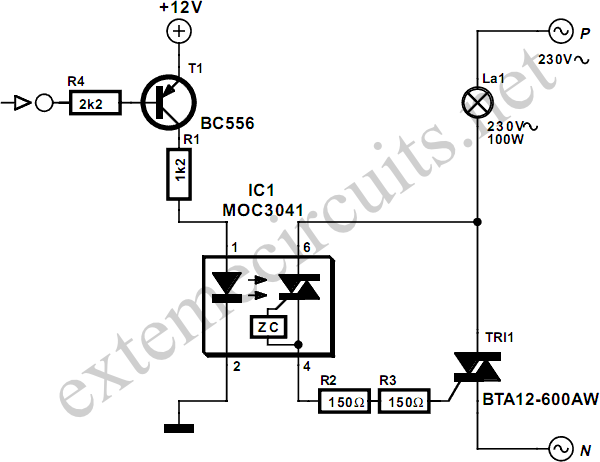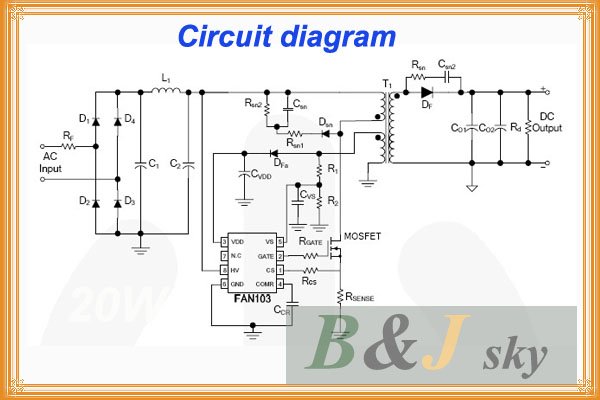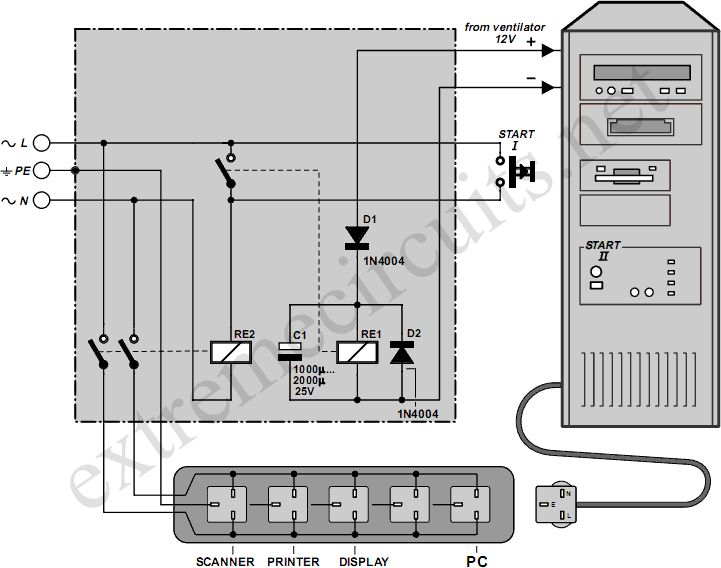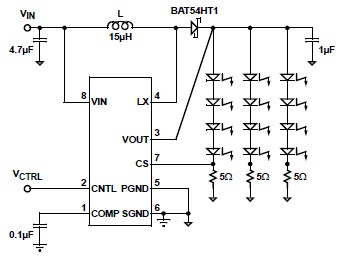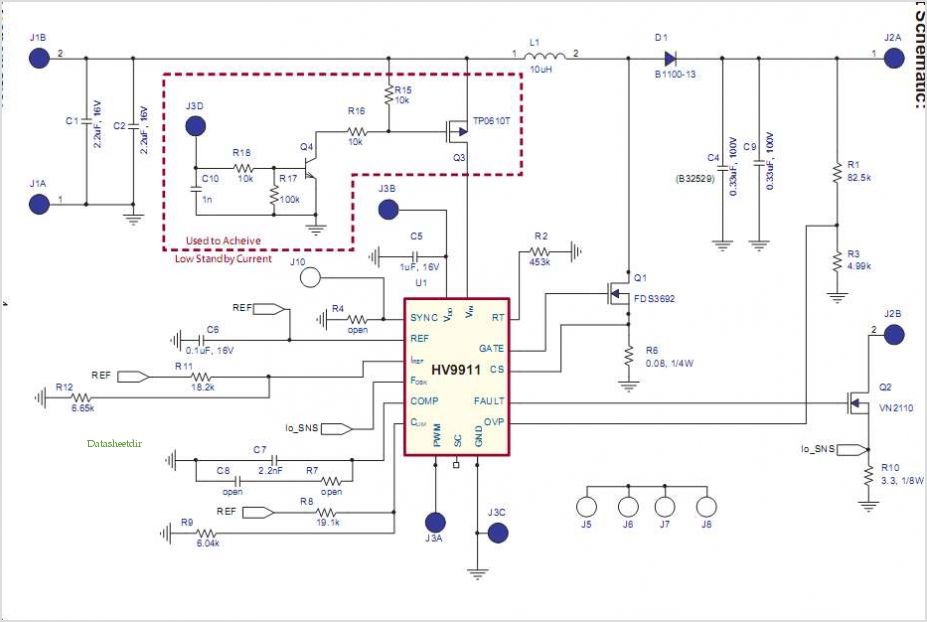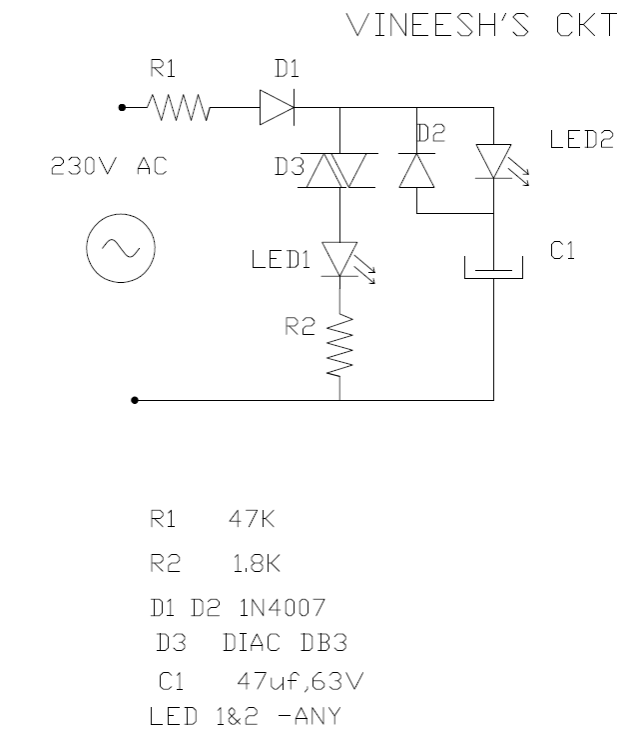
Mains clearance in a TRIAC driver
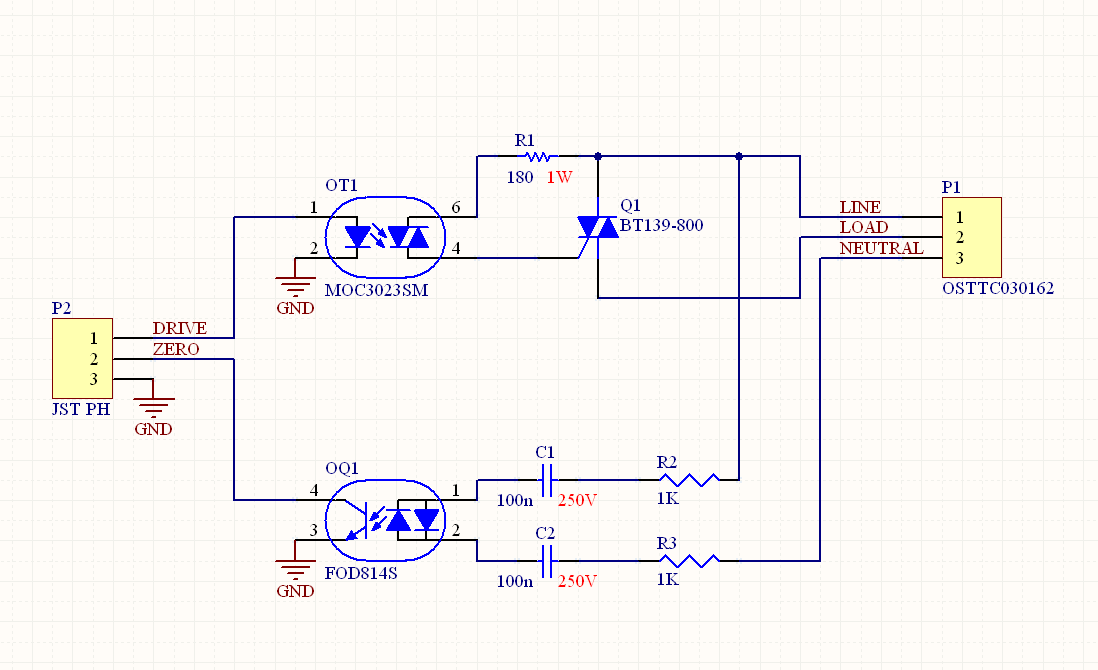
A TRIAC driver board designed for use in a reflow toaster oven project, which operates at mains voltages. According to IPC-2221, U.S. mains voltages necessitate a clearance of 0.4mm when coated with solder mask. Several questions arise: Is it permissible to run overlapping tracks on both sides of the board? The PCB thickness is unspecified, but it is a standard 2-layer FR4 PCB. The 200 mil tracks (actually fills) connecting the screw terminal to the TRIAC must either overlap or taper at the ends. What is the required clearance between the high-voltage and low-voltage sections? The separation has been maintained at least as wide as the opto-isolators. Although clearance checks are ongoing, any feedback regarding the circuit or PCB design is appreciated. The schematic's top section represents the TRIAC driver, while the bottom section is a zero-crossing detector. There is curiosity about the necessity of two capacitors and two resistors for the detector, a configuration derived from a Fairchild application note lacking voltage or safety ratings, leading to conservative assumptions. For the zero-cross detector, a single resistor may suffice in place of two capacitors and two 1K resistors, but a high power rating resistor (10K/5W for 120V AC or 22K/7W for 240V AC) will be required. The choice against using a zero-crossing opto-TRIAC stems from the intention to implement PWM on the output. The detector is intended to synchronize pulses with the AC waveform while allowing delays for variable power levels. A snubber is not utilized since the load remains purely resistive. The connector's position is dictated by a large heatsink. There is a plan to relocate it to the right side to minimize PCB size. Questions arise regarding the recommendation for narrower tracks and solder coating, as the conductance of solder is perceived as inferior, although its thickness compared to copper may mitigate this concern. Additionally, the necessity for full 3.2mm clearance as per IPC-2221 arises from the lack of soldermask coating on the tracks. The importance of accounting for the phase shift created by capacitors limiting current to the LEDs is acknowledged. In a predominantly capacitive circuit, the current leads the voltage by 90 degrees, resulting in one LED turning on while the other turns off as the mains voltage peaks, which may briefly turn off the TRIAC. The use of solder to augment trace thickness is not viewed as problematic, especially for short PCB traces. Clarification is provided that the reference to mains-to-mains clearance pertains to IPC-2221 guidelines at 170V peak-to-peak, with the low-voltage side remaining isolated from high-voltage tracks.
The TRIAC driver board is designed to manage high-voltage AC loads, making it essential to adhere to safety and clearance standards outlined in IPC-2221. The use of a 2-layer FR4 PCB is standard in such applications, providing adequate insulation and mechanical stability. The overlapping or tapering of tracks is a critical consideration in high-voltage designs, as it can affect the dielectric breakdown and overall reliability of the circuit.
The separation between high-voltage and low-voltage sections must exceed the minimum clearance requirements, which ensures safety against accidental shorts and arcing. The zero-crossing detector circuit, while simple, plays a crucial role in synchronizing the TRIAC operation with the AC waveform, enabling effective PWM control. The choice of components, specifically the power rating of resistors and capacitors, must be carefully considered to handle the expected voltage and current levels.
In terms of layout, the positioning of the heatsink is vital for thermal management, especially in high-current applications. The decision to avoid a snubber circuit is justified if the load remains purely resistive; however, it is essential to monitor the system for any potential inductive effects that could arise from wiring or component placement.
The discussion regarding solder thickness and track width is pertinent, as increased trace thickness can enhance current-carrying capacity, but it must be balanced with PCB design rules to prevent excessive heat generation and ensure reliable operation. The phase shift due to capacitive elements in the circuit can significantly influence the timing of the TRIAC's operation and should be taken into account during the design phase.
Overall, the design of the TRIAC driver board should focus on maintaining safety, reliability, and efficiency through careful consideration of component selection, layout, and adherence to established electrical standards.A TRIAC driver board for use with my reflow toaster oven project, which means mains voltages. IPC-2221 says that U. S. mains voltages require 0. 4mm clearance if coated with solder mask. A few questions: Can I run overlapping tracks on both sides of the board I don`t know how thick the PCB is but it`s a standard, 2-layer FR4 PCB. Since the 200 mil "tracks" (fills, actually) running from the screw terminal to the TRIAC are sort of, erm, wide, they have to either overlap or taper at the ends. How much clearance do I need between the high-voltage section and the low-voltage section I`ve kept them at least as far apart as the opto-isolators are wide but I`m curious what the standards say. I haven`t finished checking clearances yet but any comments about the circuit or the PCB are welcome.
The top of the schematic is the TRIAC driver of course, and the bottom is a zero-crossing detector. I`m especially curious whether I really need two capacitors and two resistors for the detector, I got that from a Fairchild app note but there weren`t any voltage or safety ratings in the example so I had to assume the worst. For the zero-cross detector you can use only a single resistor instead of two caps and two 1K resistors but you will need a high power rating resistor (10K/5W for 120V AC mains or 22K/7W for 240V AC).
Thanks for the advice. The reason I`m not using a zero-crossing opto-TRIAC is that I want to PWM the output - the detector is for keeping the pulses in sync with the AC waveform while still allowing me to delay them to get the varying levels of power I want. I also opted not to use a snubber since the load is always purely resistive, and the connector is where it is because that big pink thing is a rather large heatsink :-) That said, I do intend to move it to the right-hand side in an attempt to squeeze this onto a smaller PCB.
Why do you recommend narrower tracks and solder coating I thought the conductance of solder was relatively bad, but I guess that would matter less since it would be much thicker than the copper. Another problem is that the tracks would no longer be soldermask-coated so I would need the full 3. 2mm clearance required by IPC-2221. Thanks for the advice. The reason I`m not using a zero-crossing opto-TRIAC is that I want to PWM the output - the detector is for keeping the pulses in sync with the AC waveform while still allowing me to delay them to get the varying levels of power I want.
I also opted not to use a snubber since the load is always purely resistive, and the connector is where it is because that big pink thing is a rather large heatsink :-) That said, I do intend to move it to the right-hand side in an attempt to squeeze this onto a smaller PCB. Why do you recommend narrower tracks and solder coating I thought the conductance of solder was relatively bad, but I guess that would matter less since it would be much thicker than the copper.
I hope you`re aware you need to account for the phase shift generated by the capacitors you`ve used to limit the current to the LEDs. In a purely capacitive circuit (which nearly to what you have) the current leads the voltage by 90o so one LED will turn on and the other turn off as the mains voltage passes its peak, which will briefly turn 0Q1 off for a few hundred µs.
I don`t see what`s the problem in using solder to make the traces thicker. We are not talking about 1km of PCB trace; just a few centimeters. If it works for car amplifiers where the currents are around 40-60A (and with longer PCB traces) then I really don`t see a problem with this application. You don`t have to leave entire trace exposed - just leave the middle of the trace exposed. 120V. I was referring to mains-to-mains clearance, not low-voltage clearance, according to IPC-2221 rules at 170V peak-to-peak.
The low-voltage side is still off in its own little corner no matter what I do to the high-voltage tracks. It`s i 🔗 External reference
The TRIAC driver board is designed to manage high-voltage AC loads, making it essential to adhere to safety and clearance standards outlined in IPC-2221. The use of a 2-layer FR4 PCB is standard in such applications, providing adequate insulation and mechanical stability. The overlapping or tapering of tracks is a critical consideration in high-voltage designs, as it can affect the dielectric breakdown and overall reliability of the circuit.
The separation between high-voltage and low-voltage sections must exceed the minimum clearance requirements, which ensures safety against accidental shorts and arcing. The zero-crossing detector circuit, while simple, plays a crucial role in synchronizing the TRIAC operation with the AC waveform, enabling effective PWM control. The choice of components, specifically the power rating of resistors and capacitors, must be carefully considered to handle the expected voltage and current levels.
In terms of layout, the positioning of the heatsink is vital for thermal management, especially in high-current applications. The decision to avoid a snubber circuit is justified if the load remains purely resistive; however, it is essential to monitor the system for any potential inductive effects that could arise from wiring or component placement.
The discussion regarding solder thickness and track width is pertinent, as increased trace thickness can enhance current-carrying capacity, but it must be balanced with PCB design rules to prevent excessive heat generation and ensure reliable operation. The phase shift due to capacitive elements in the circuit can significantly influence the timing of the TRIAC's operation and should be taken into account during the design phase.
Overall, the design of the TRIAC driver board should focus on maintaining safety, reliability, and efficiency through careful consideration of component selection, layout, and adherence to established electrical standards.A TRIAC driver board for use with my reflow toaster oven project, which means mains voltages. IPC-2221 says that U. S. mains voltages require 0. 4mm clearance if coated with solder mask. A few questions: Can I run overlapping tracks on both sides of the board I don`t know how thick the PCB is but it`s a standard, 2-layer FR4 PCB. Since the 200 mil "tracks" (fills, actually) running from the screw terminal to the TRIAC are sort of, erm, wide, they have to either overlap or taper at the ends. How much clearance do I need between the high-voltage section and the low-voltage section I`ve kept them at least as far apart as the opto-isolators are wide but I`m curious what the standards say. I haven`t finished checking clearances yet but any comments about the circuit or the PCB are welcome.
The top of the schematic is the TRIAC driver of course, and the bottom is a zero-crossing detector. I`m especially curious whether I really need two capacitors and two resistors for the detector, I got that from a Fairchild app note but there weren`t any voltage or safety ratings in the example so I had to assume the worst. For the zero-cross detector you can use only a single resistor instead of two caps and two 1K resistors but you will need a high power rating resistor (10K/5W for 120V AC mains or 22K/7W for 240V AC).
Thanks for the advice. The reason I`m not using a zero-crossing opto-TRIAC is that I want to PWM the output - the detector is for keeping the pulses in sync with the AC waveform while still allowing me to delay them to get the varying levels of power I want. I also opted not to use a snubber since the load is always purely resistive, and the connector is where it is because that big pink thing is a rather large heatsink :-) That said, I do intend to move it to the right-hand side in an attempt to squeeze this onto a smaller PCB.
Why do you recommend narrower tracks and solder coating I thought the conductance of solder was relatively bad, but I guess that would matter less since it would be much thicker than the copper. Another problem is that the tracks would no longer be soldermask-coated so I would need the full 3. 2mm clearance required by IPC-2221. Thanks for the advice. The reason I`m not using a zero-crossing opto-TRIAC is that I want to PWM the output - the detector is for keeping the pulses in sync with the AC waveform while still allowing me to delay them to get the varying levels of power I want.
I also opted not to use a snubber since the load is always purely resistive, and the connector is where it is because that big pink thing is a rather large heatsink :-) That said, I do intend to move it to the right-hand side in an attempt to squeeze this onto a smaller PCB. Why do you recommend narrower tracks and solder coating I thought the conductance of solder was relatively bad, but I guess that would matter less since it would be much thicker than the copper.
I hope you`re aware you need to account for the phase shift generated by the capacitors you`ve used to limit the current to the LEDs. In a purely capacitive circuit (which nearly to what you have) the current leads the voltage by 90o so one LED will turn on and the other turn off as the mains voltage passes its peak, which will briefly turn 0Q1 off for a few hundred µs.
I don`t see what`s the problem in using solder to make the traces thicker. We are not talking about 1km of PCB trace; just a few centimeters. If it works for car amplifiers where the currents are around 40-60A (and with longer PCB traces) then I really don`t see a problem with this application. You don`t have to leave entire trace exposed - just leave the middle of the trace exposed. 120V. I was referring to mains-to-mains clearance, not low-voltage clearance, according to IPC-2221 rules at 170V peak-to-peak.
The low-voltage side is still off in its own little corner no matter what I do to the high-voltage tracks. It`s i 🔗 External reference
